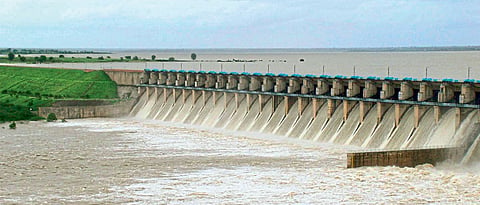

Pune: Despite the rainfall over the past month, the majority of the 26 reservoirs in the Bhima basin, including prominent ones like Ujani, Pimpalgaon Joge, Manikdoh, Yedgaon, Wadaj, Dimbhe, Ghod, Visapur, Chilhewadi, Kalmodi, Chas Kaman, Bhama Askhed, Wadivale, Andra, Pavana, Kasarsai, Mulshi, Temghar, Warasgaon, Panshet, Khadakwasla, Gunjavani, Neera Devdhar, Bhatghar, Veer, and Nazare, have not reached satisfactory levels.
Currently, only three reservoirs—Kalmodi at 40%, and Wadivale and Khadakwasla at 51%—have exceeded the 35% capacity threshold. The rest remain below this mark, indicating that the rainfall has not been sufficient to fill these critical water sources.
This situation has a direct effect on the Ujani Dam, which depends on the upstream reservoirs for significant inflows. As a result, Ujani Dam has not yet achieved a positive water level, though it is receiving an inflow of 4,000 cusecs.
The water level at Ujani Dam had dropped to -60% during the summer and has now improved to -34%. In response to the summer shortage, the municipality had initiated double pumping on March 25 when the water level hit -35%. With the recent improvement to -34%, double pumping was halted on July 11, resulting in a monthly savings of ₹2.5 million.
Solapur city's water supply depends on Ujani Dam, requiring water releases from the Bhima River when needed. The Auj and Chinchpur weirs near Solapur can hold 0.80 TMC of water, but around 5 TMC must be released from the dam to fill them.
Additionally, the municipality draws water daily through an old pipeline at the dam. Despite these measures, the city's water supply is still on a four to five-day rotation. Under the leadership of public engineer Venkatesh Chaube, effective planning ensured a steady water supply during the summer.
When the dam's level improved from -60% to below -50%, triple pumping was stopped, saving the municipality an estimated ₹6.5 million. Now, with the cessation of double pumping, further savings are realized.
Double pumping from the dam was initiated by the Solapur municipality on March 25 for city water supply.
Triple pumping was required starting May 15 when the dam level reached -51%.
Due to rainfall in the dam area, the level improved to -50% on June 14, halting triple pumping.
With the dam now at -34%, double pumping was stopped on Thursday (July 11).
